Risk Assessment of Heavy Rain Disasters Using an Interpretable Random Forest Algorithm Enhanced by MAML
Abstract
1. Introduction
2. Materials and Methods
2.1. Regional Overview
2.2. Data Description
2.3. Research Methodology and Model Construction
2.3.1. Identification of Heavy Rain Events
2.3.2. Heavy Rain Disaster Dataset
2.3.3. SCV-RF Model
- Selection of Hyperparameters for Optimization: To balance the complexity and generalization ability of the SCV-RF model, the following hyperparameters are chosen for optimization: number of decision trees (n_estimators), maximum depth of the decision trees (max_depth), minimum number of samples required to split an internal node (min_samples_split), and minimum number of samples required at a leaf node (min_samples_leaf) [31].
- Setting the Range for Hyperparameter Optimization: The ranges are set as follows: n_estimators [between 1, and 100], max_depth [from 1, to 20], min_samples_split [from 2, to 10], and min_samples_leaf [between 1, and 10].
- Random Search and Model Training: Within the specified hyperparameter ranges, a set of hyperparameters is randomly sampled and evaluated for simulation accuracy using five-fold cross-validation. This random sampling and model training process is repeated 100 times, with the set of hyperparameters yielding the highest model accuracy selected as the final optimized parameters for the SCV-RF model.
2.3.4. Improved MAML-RF-SHAP Model
2.3.5. Model Accuracy Evaluation
3. Results
3.1. Evolution Characteristics of Heavy Rain Disaster-Causing Factors
3.1.1. Trend Changes
3.1.2. Intra-Annual Variation
3.1.3. Spatial Variation
3.2. Heavy Rain Disaster Risk Assessment
3.2.1. Risk Assessment System
- (1)
- Heavy Rain Disaster-Inducing Factors: This study selects the number of heavy rain days, rainfall amount, and rainfall contribution rate as the disaster-inducing factors. The principles for their selection and the analysis of their spatiotemporal variation characteristics are detailed in Section 3.1 above.
- (2)
- Disaster-Prone Environment for Heavy Rain: This refers to the natural and socio-cultural environments that play a role in disasters under the influence of heavy rain. The slope of the land affects the direction and speed of surface runoff, influencing the degree of water accumulation. The steeper the slope, the shorter the time for floodwaters to gather in low-lying areas, increasing disaster risk. The extent of the impervious surface area directly affects the infiltration of surface runoff and the drainage pressure on the sewer system. Therefore, slope and impervious surface ratio are considered as risk factors for the disaster-prone environment.
- (3)
- Disaster-Bearing Bodies for Heavy Rain: These are the objects affected by disaster-inducing factors, primarily the population, buildings, and socio-economic aspects within a region. Thus, this paper uses population density, GDP per unit area, and land use type to describe the disaster-bearing bodies [30]. The greater the population density, GDP density, and utilization level in a region, the greater the potential loss in the event of a disaster.
- (4)
- Disaster Mitigation Capacity for Heavy Rain: This refers to a city’s ability to prevent and respond to disasters. The greater the density of drainage pipes, the greater the drainage capacity, and the lower the risk of heavy rain disasters. Additionally, since heavy rain disasters often accompany road collapses, leading to urban road system failures or partial paralysis, road network density is also considered an indicator of disaster mitigation capacity.
3.2.2. Risk Factor Dimensionality Reduction
3.2.3. Model Parameter Settings
3.2.4. Model Evaluation Result
3.2.5. SHAP Algorithm Interpretation Results
3.2.6. Risk Assessment and Validation
4. Discussion
- Between 2000 and 2010, the areas classified as relatively high and high-risk zones accounted for 40–50% of the total area, primarily located in southern and eastern Hebei Province and Beijing. This may be due to low density of drainage network construction, frequent industrial activities, high density of factory buildings, and inadequate planning, design, and management of flood control and drainage facilities during this period. These issues led to the drainage systems operating beyond capacity, with rainfall intensity in some areas exceeding the design standards of drainage pipes, resulting in widespread waterlogging and flooding of main roads, severely disrupting transportation and causing extensive heavy rain disaster losses.
- In 2012, the Beijing–Tianjin–Hebei region experienced a three-day extreme heavy rain event. Assessment results showed that the persistent rainfall significantly impacted medium and relatively high-risk areas, which were highly concentrated in Qinhuangdao, Tangshan, Baoding in Hebei Province, Tianjin, and southeastern Beijing. These areas, located on the flat and low-lying North China Plain, suffered from inadequate planning and construction of flood control and drainage facilities, incomplete urban drainage systems, and prominent issues of drainage network aging, damage, and siltation. These factors slowed rainwater infiltration and significantly increased surface runoff, exacerbating the extent of heavy rain disaster losses. This also exposed deficiencies in the disaster prevention and mitigation systems and the collaborative control capabilities of engineering facilities in response to extreme precipitation events, causing severe disruptions to urban transportation and residents’ lives.
- In 2016, high-risk zones in Hebei Province emerged in the foothill areas at the junction of the North China Plain and the mountains, such as western Handan, western Shijiazhuang, central Xingtai, and east-central Chengde. This may be due to the obstructive and uplifting effects of mountainous terrain, which caused intense surface runoff to form in local areas during heavy rain, quickly converging into mountain streams and leading to road collapses, landslides, and other disasters, significantly elevating the risk levels of heavy rain disasters in these regions. Additionally, based on disaster risk assessment results, high-risk zones for heavy rain disasters mainly appeared in river networks such as the Ziya New River, South Canal, and Chaobai River, as well as in southeastern floodplain areas. This spatial distribution is closely related to regional topography: on one hand, these areas are located in low-lying alluvial plains with poor drainage conditions; on the other hand, some upstream areas have mountainous terrain, where intense rainfall causes mountain floods to rapidly flow downstream, creating significant flood overlay effects. This hydrological process not only increases downstream disaster risk but also causes losses to agricultural production and other socio-economic systems.
- In urban planning and management, strengthen the construction, renovation, and risk assessment of flood control and drainage facilities to improve infrastructure quality.
- In areas at the junction of plains and mountains, such as western Hebei, northern Beijing, and older residential areas in the study region, provide effective heavy rain warnings, develop emergency plans for different risk levels, and ensure timely relocation and disaster relief efforts. Additionally, strictly regulate river channel filling, install protective river facilities, stabilize unstable slopes, and build check dams downstream of gullies to reduce the impact of secondary disasters like landslides, thereby maximizing public safety [54].
- Provinces and cities should enhance underground network infrastructure, expedite drainage network upgrades in urban areas, boost flood control and drainage capabilities, develop low-impact rainwater systems, and strengthen sponge city construction to better cope with future heavy rain challenges.
5. Conclusions
- (1)
- The number of heavy rain days and the annual characteristics of heavy rain show a downward trend, but a significant upward trend from 2000 to 2017.
- (2)
- The MAML-RF model improved simulation accuracy, precision, and recall by 4.44%, 3.71%, and 4.44%, respectively, over the SCV-RF model, while also reducing simulation time by 2.06 s. This indicates that the improved MAML-RF model provides superior output results in assessing heavy rain disaster risk, demonstrating high robustness and generalization capability.
- (3)
- The introduction of the SHAP interpretability algorithm for analyzing the MAML-RF model revealed that five heavy rain disaster risk factors—number of heavy rain days, rainfall amount, slope, drainage pipe density, and impervious surface ratio—have the most significant impact on disaster risk. The driving effect of these disaster-inducing factors on heavy rain disaster risk is more pronounced compared to the disaster-prone environment, disaster-bearing body, and disaster mitigation capacity, with a cumulative influence weight reaching 0.519.
- (4)
- The spatiotemporal distribution of heavy rain disaster risk has exhibited significant changes. The area of high-risk within the region has increased. Relatively high-risk and high-risk areas are mainly distributed in the south-central part of Beijing, southern Hebei Province cities such as Shijiazhuang, Hengshui, and Xingtai, eastern Hebei cities like Chengde and Qinhuangdao, and southern Tianjin. The area proportion of medium-risk zones to the area remains relatively stable. Low-risk areas for the disaster are clustered in the northwestern plateau area.
Author Contributions
Funding
Institutional Review Board Statement
Informed Consent Statement
Data Availability Statement
Acknowledgments
Conflicts of Interest
References
- Wang, G.; Zhang, Q.; Yu, H.; Shen, Z.; Sun, P. Double increase in precipitation extremes across China in a 1.5 °C/2.0 °C warmer climate. Sci. Total Environ. 2020, 746, 140807. [Google Scholar] [CrossRef] [PubMed]
- Wang, J.; Tan, J.K. Understanding the climate change and disaster risks in coastal areas of China to develop coping strategies. Prog. Geogr. 2021, 40, 870–882. [Google Scholar] [CrossRef]
- Sun, Y.H.; Zhang, W. The Logical Turn and Implementation Path of Public Security System Construction in the New Era: A Study Based on the Framework of Overall Security and Emergency Response. Jianghai Acad. J. 2024, 2, 131–139. [Google Scholar]
- Tang, J.; Li, Y.; Cui, S.; Xu, L.; Hu, Y.; Ding, S.; Vilas, N. Analyzing the spatiotemporal dynamics of flood risk and its driving factors in a coastal watershed of southeastern China. Ecol. Indic. 2021, 121, 107134. [Google Scholar] [CrossRef]
- Wang, Y.J.; Zhai, J.Q.; Ge, G.; Liu, Q.F.; Song, L.C. Risk Assessment of Rainstorm Disasters in the Guangdong–Hong Kong–Macao Greater Bay Area of China during 1990–2018. Geomatics. Nat. Hazards Risk 2021, 13, 267–288. [Google Scholar] [CrossRef]
- Fu, H.E.; Gao, Y.J.; Feng, Y.Y.; Huang, J.Y.; Liu, Z.F. Hazard prediction of urban rainstorm and flood disasters based on GA–SVR–C model: Case study of Shenzhen City. Yangtze River 2021, 52, 16–21. [Google Scholar]
- Wu, M.M.; Wu, Z.N.; Ge, W.; Wang, H.L.; Shen, Y.X.; Jiang, M.M. Identification of sensitivity indicators of urban rainstorm flood disasters: A case study in China. J. Hydrol. 2021, 599, 126393. [Google Scholar] [CrossRef]
- Zhou, C.; Si, L.L.; Zhao, L.; Lang, Z.Q.; Fu, Z.Z. Refined evaluation of maize flood disaster based on Google Earth Engine: A case study of the “23·7” heavy precipitation process in Baoding City, Hebei Province. Chin. J. Eco-Agric. 2025, 33, 1–11. [Google Scholar]
- Wang, X.W.; Ning, Y.Z.; Fang, Y.J.; Yuan, P.Q.; Gao, Y.X.; Zhong, Z.W.; Chen, D.A.; Li, X.; Chen, D.S. A technique framework and implementation for rapid survey and assessment of flood disasters: A case study in the North River Basin in June 2022. Water Resour. Hydropower Eng. 2023, 54, 1–20. [Google Scholar]
- Zhao, Z.N.; Wang, L.R.; Wang, C.M.; Han, X.Q. Risk Distribution Characteristics of Rainstorm and Flood Disaster Based on Flood Area Model in the Xiaoma River Basin of Xingtai. J. Arid Meteorol. 2021, 39, 486–493. [Google Scholar]
- Chen, J.F.; Liu, L.M.; Pei, J.P.; Deng, M.H. An ensemble risk assessment model for urban rainstorm disasters based on random forest and deep belief nets: A case study of Nanjing, China. Nat. Hazards 2021, 107, 2671–2692. [Google Scholar] [CrossRef]
- Xie, T.; Yu, L.; Zhou, H.; Qin, W.S. Evaluation of dual-Doppler radar wind retrieval methods based on observation system simulation experiment. J. Meteorol. Sci. 2024, 44, 1140–1153. [Google Scholar]
- Fang, X.; Wu, X.; Zhou, C.; Wu, T.; Du, X.; Wang, W. Risk Assessment of Mountain Torrents Disaster in Jiangxi Province, China Based on Random Forest Algorithm. In Proceedings of the IGARSS 2019—2019 IEEE International Geoscience and Remote Sensing Symposium, Yokohama, Japan, 28 July–2 August 2019; pp. 9752–9755. [Google Scholar]
- Huang, X.; Zhao, H.; Huang, Y.; Wu, Y. Prediction model based on the Laplacian eigenmap method combined with a random forest algorithm for rainstorm satellite images during the first annual rainy season in South China. Nat. Hazards 2021, 107, 331–353. [Google Scholar] [CrossRef]
- Lai, C.G.; Chen, X.H.; Zhao, S.W.; Wang, Z.L.; Wu, X.S. A flood risk assessment model based on Random Forest and its application. J. Hydraul. Eng. 2015, 46, 58–66. [Google Scholar]
- Iverson, L.R.; Prasad, A.M.; Matthews, S.N.; Peters, M. Estimating potential habitat for 134 eastern US tree species under six climate scenarios. For. Ecol. Manag. 2008, 254, 390–406. [Google Scholar] [CrossRef]
- Wang, J.; Feng, J.; Yan, Z. Impact of extensive urbanization on summertime rainfall in the Beijing region and the role of local precipitation recycling. J. Geophys. Res. Atmos. 2018, 123, 3323–3340. [Google Scholar] [CrossRef]
- Zhang, J.; You, S.; Liu, A.; Xie, L.; Huang, C.; Han, X.; Li, P.; Wu, Y.; Deng, J. Winter Wheat Mapping Method Based on Pseudo-Labels and U-Net Model for Training Sample Shortage. Remote Sens. 2024, 16, 2553. [Google Scholar] [CrossRef]
- Philipp, P.; Marvin, N.W.; Anne, L.B. Hyperparameters and tuning strategies for random forest. WIREs Data Min. Knowl. Discov. 2019, 9, 3. [Google Scholar]
- Rui, Q.; Yu, Z.; Zhu, R. Random Forest Weighted Local Fréchet Regression with Random Objects. J. Mach. Learn. Res. 2022, 107, 1–69. [Google Scholar]
- Chen, X.J.; Han, X.L.; Zhang, L.; Wu, Z.H.; Ji, J. Parameter optimization of steel-concrete beam and column fiber elements based on random forest algorithm. J. Harbin Inst. Technol. 2024, 1–15. [Google Scholar]
- Gao, X.B.; Jia, B.; Li, G.; Ma, X.J. Coal-gangue calorific value prediction based on machine learning algorithm combined with parameter optimization. Mod. Electron. Tech. 2023, 46, 168–174. [Google Scholar]
- Kadam, V.; Jadhav, S. Performance analysis of hyperparameter optimization methods for ensemble learning with small and medium sized medical datasets. J. Discret. Math. Sci. Cryptogr. 2020, 23, 115–123. [Google Scholar] [CrossRef]
- Liu, C.H.; Zhang, W.M.; Xue, F. Research on kinematic parameters optimization of robot arm based on random forest Bayesian optimization. Manuf. Technol. Mach. Tools 2023, 727, 83–90. [Google Scholar]
- Shi, S.; Bao, J.; Guo, Z.; Han, Y.; Xu, Y.; Ugochi, U.; Zhao, L.; Jiang, N.; Sun, L.; Liu, X.; et al. Improving prediction of N2O emissions during composting using model-agnostic meta-learning. Sci. Total Environ. 2024, 922, 171357. [Google Scholar] [CrossRef] [PubMed]
- Wang, G.P.; Liu, L.Y.; Hu, Z.Y. Risk Assessment of Rainstorm and Flood Disasters at Grid-scale in Beijing-Tianjin-Hebei Metropolitan Area. J. Catastrophology 2020, 35, 186–193. [Google Scholar]
- Wang, W.; Miao, C.; Yu, H.; Li, C. Research on the characteristics and influencing factors of the Beijing-Tianjin-Hebei urban network structure from the perspective of listed manufacturing enterprises. PLoS ONE 2023, 18, e0279588. [Google Scholar] [CrossRef]
- Wang, Y.J.; Lin, X. A review of climate change and its impact and adaptation in Beijing-Tianjin-Hebei urban agglomeration. Clim. Change Res. 2022, 18, 743–755. [Google Scholar]
- Nardi, F.; Annis, A.; Di Baldassarre, G.; Vivoni, E.R.; Grimaldi, S. GFPLAIN250m, a global high-resolution dataset of Earth’s floodplains. Sci. Data 2019, 6, 180309. [Google Scholar] [CrossRef]
- GB/T 33680-2017; Grades of Rainstorm Disaster. National Technical Committee on Climate and Climate Change Standardization: Beijing, China, 2017; pp. 1–7.
- Contreras, P.; Orellana-Alvear, J.; Muñoz, P.; Bendix, J.; Célleri, R. Influence of Random Forest Hyperparameterization on Short-Term Runoff Forecasting in an Andean Mountain Catchment. Atmosphere 2021, 12, 238. [Google Scholar] [CrossRef]
- Li, Y.; Gong, S.; Zhang, Z.; Liu, M.; Sun, C.; Zhao, Y. Vulnerability evaluation of rainstorm disaster based on ESA conceptual framework: A case study of Liaoning province, China. Sustain. Cities Soc. 2021, 64, 102540. [Google Scholar] [CrossRef]
- Shen, R.S.; Chen, T.T.; Yang, H.Z. Risk Assessment and Driving Factors of Urban Rainstorm and Waterlogging Disasters: A Case Study of the Eight Districts of Hangzhou. Urban Planning Society of China, Hefei Municipal People’s Government. In Beautiful China, Co-construction, Co-governance and Sharing-Proceedings of the 2024 China Urban Planning Annual Conference (02 Urban Safety and Disaster Prevention Planning); Zhejiang University of Technology: Hangzhou, China, 2024; pp. 467–477. [Google Scholar]
- Erik, Š.; Kononenko, I. Explaining prediction models and individual predictions with feature contributions. Knowl. Inf. Syst. 2014, 41, 647–665. [Google Scholar]
- Meng, D.; Li, X.J.; Gong, H.L.; Qu, Y.T. Analysis of Spatial-Temporal Change of NDVI and Its Climatic Driving Factors in Beijing-Tianjin-Hebei Metropolis Circle from 2001 to 2013. J. Geo-Inf. Sci. 2015, 17, 1001–1007. [Google Scholar]
- Wang, J.C.; Dong, L.J. Risk assessment of rockburst using SMOTE oversampling and integration algorithms under GBDT framework. J. Cent. South Univ. 2024, 31, 2891–2915. [Google Scholar] [CrossRef]
- Yao, Y.; Li, X.H.; Wang, L.; Li, H. Future Projection of Rainstorm and Flood Disaster Risk in Sichuan-Chongqing Region under CMIP6 Different Climate Change Scenarios. Plateau Meteorol. 2024, 1–18. [Google Scholar] [CrossRef]
- Ji, Z.C.; Zhang, D.; Yu, X. Analysis of the spatiotemporal characteristics of the danger degree of the torrential rain in the Huaihe River basin. Torrential Rain Disasters 2022, 41, 580–587. [Google Scholar]
- Xu, H.C.; Li, C.L.; Wang, H.; Liu, M.; Hu, Y.M. Impact of land use change on the spatiotemporal evolution of the regional thermal environment in the Beijing-Tianjin-Hebei urban agglomeration. China Environ. Sci. 2023, 43, 1340–1348. [Google Scholar]
- Shi, P.J. Theory and Practice of Disaster Study. J. Nat. Disasters 1996, 5, 6–17. [Google Scholar]
- Wang, C.Q.; Wang, K.X.; Liu, D.; Zhang, L.L.; Li, M. Muhammad Imran Khan, Tianxiao Li, Song Cui, Development and application of a comprehensive assessment method of regional flood disaster risk based on a refined random forest model using beluga whale optimization. J. Hydrol. 2024, 633, 130963. [Google Scholar] [CrossRef]
- Cheng, C.; Fang, X.Y.; Li, M.C.; Yang, Y.H.; Gao, Y.; Zhang, S.; Yu, Y.; Liu, Y.H.; Du, W.P. Rainstorm and high-temperature disaster risk assessment of territorial space in Beijing, China. Res. Artic. 2023, 30, 3023. [Google Scholar] [CrossRef]
- Du, S.; Shi, P.; Anton, V.; Wen, J. Quantifying the impact of impervious surface location on flood peak discharge in urban areas. Nat. Hazards 2015, 76, 1457–1471. [Google Scholar] [CrossRef]
- Han, F.; Yu, J.; Zhou, G.; Li, S.; Sun, T. A comparative study on urban waterlogging susceptibility assessment based on multiple data driven models. J. Environ. Manag. 2024, 360, 121166. [Google Scholar] [CrossRef] [PubMed]
- Xiang, X.; Zhang, S.J.; Zhao, J.; Peng, Y.Q.; Lei, A.L.; Zhu, S.J.; Wu, H.X.; Zhao, F. Spatio-temporal evolution characteristics and influencing factors analysis of meteorological disasters in typical regions of the Yunnan-Guizhou Plateau. J. Spatiotemporal Inf. 2024, 31, 118–128. [Google Scholar]
- Liu, Z.; Jiang, Z.Z.; Xu, C.; Cai, G.J.; Zhan, J. Assessment of provincial waterlogging risk based on entropy weight TOPSIS–PCA method. Nat. Hazards 2021, 108, 1545–1567. [Google Scholar] [CrossRef]
- Guo, E.L.; Zhang, J.Q.; Ren, X.H.; Zhang, Q.; Sun, Z.Y. Integrated risk assessment of flood disaster based on improved set pair analysis and the variable fuzzy set theory in central Liaoning Province, China. Nat. Hazards 2014, 74, 947–965. [Google Scholar] [CrossRef]
- Li, F.; Wang, L.; Zhao, Y. Evolvement rules of basin flood risk under low-carbon mode. Part II: Risk assessment of flood disaster under different land use patterns in the Haihe basin. Environ. Monit. Assess. 2017, 189, 397. [Google Scholar] [CrossRef]
- Wu, X.H.; Zhao, J.Q.; Kuai, Y.; Guo, J.; Gao, G. Construction and verification of a rainstorm death risk index based on grid data fusion: A case study of the Beijing rainstorm on July 21, 2012. Nat. Hazards 2021, 107, 2293–2318. [Google Scholar] [CrossRef]
- China Meteorological Administration. China Meteorological Disaster Yearbook; China Meteorological Press: Beijing, China, 2004. [Google Scholar]
- China Meteorological Administration. China Meteorological Disaster Yearbook; China Meteorological Press: Beijing, China, 2006. [Google Scholar]
- China Meteorological Administration. China Meteorological Disaster Yearbook; China Meteorological Press: Beijing, China, 2013. [Google Scholar]
- China Meteorological Administration. China Meteorological Disaster Yearbook; China Meteorological Press: Beijing, China, 2017. [Google Scholar]
- Yang, J.P.; Chen, N.S.; Yang, Z.Q.; Peng, X.T.; Tian, S.F.; Huang, N. Risk amplification effect caused by main stream road bridges and culverts blockages due to debris flow. Chin. J. Geol. Hazard Control 2024, 35, 120–132. [Google Scholar]
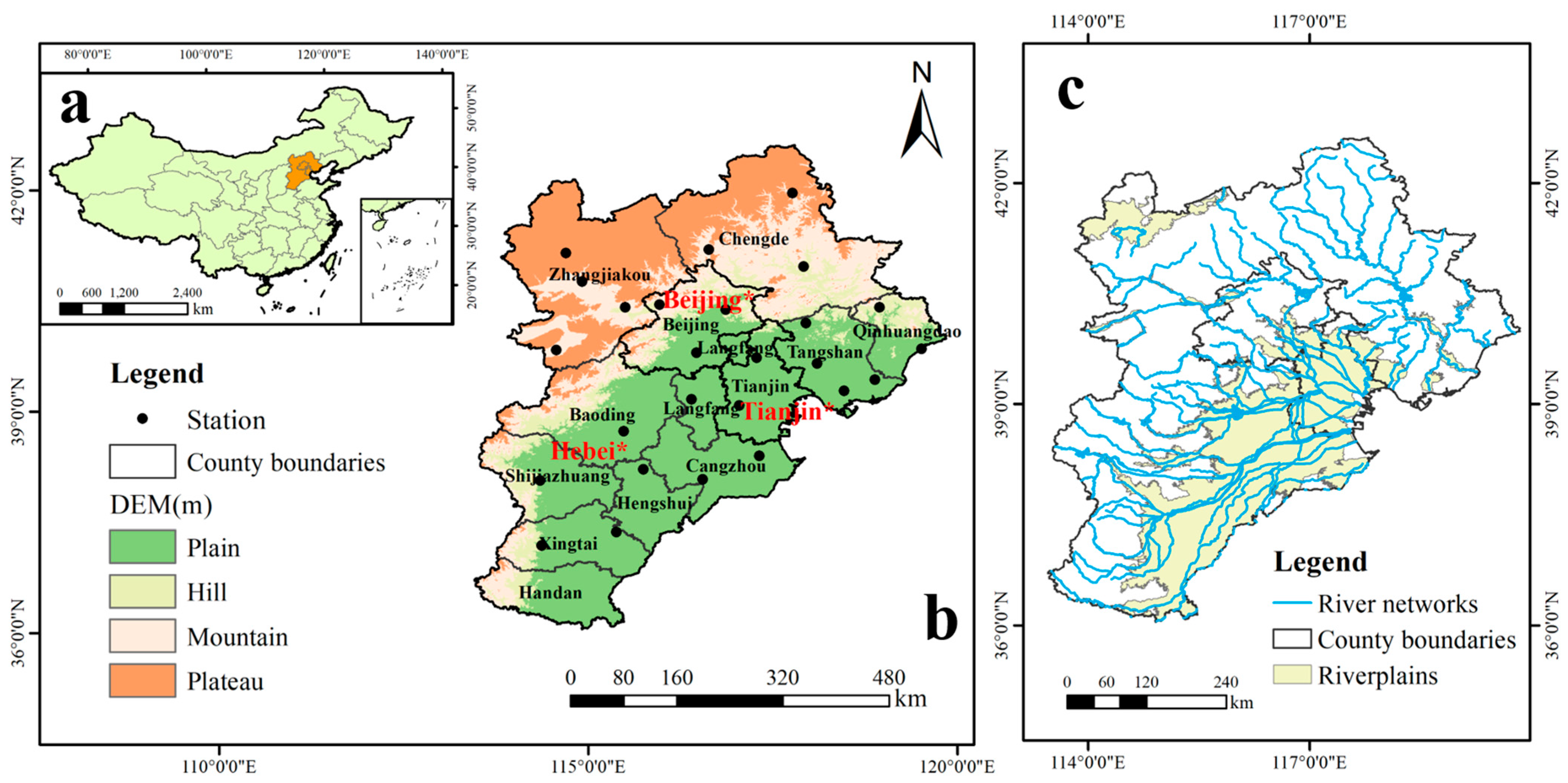


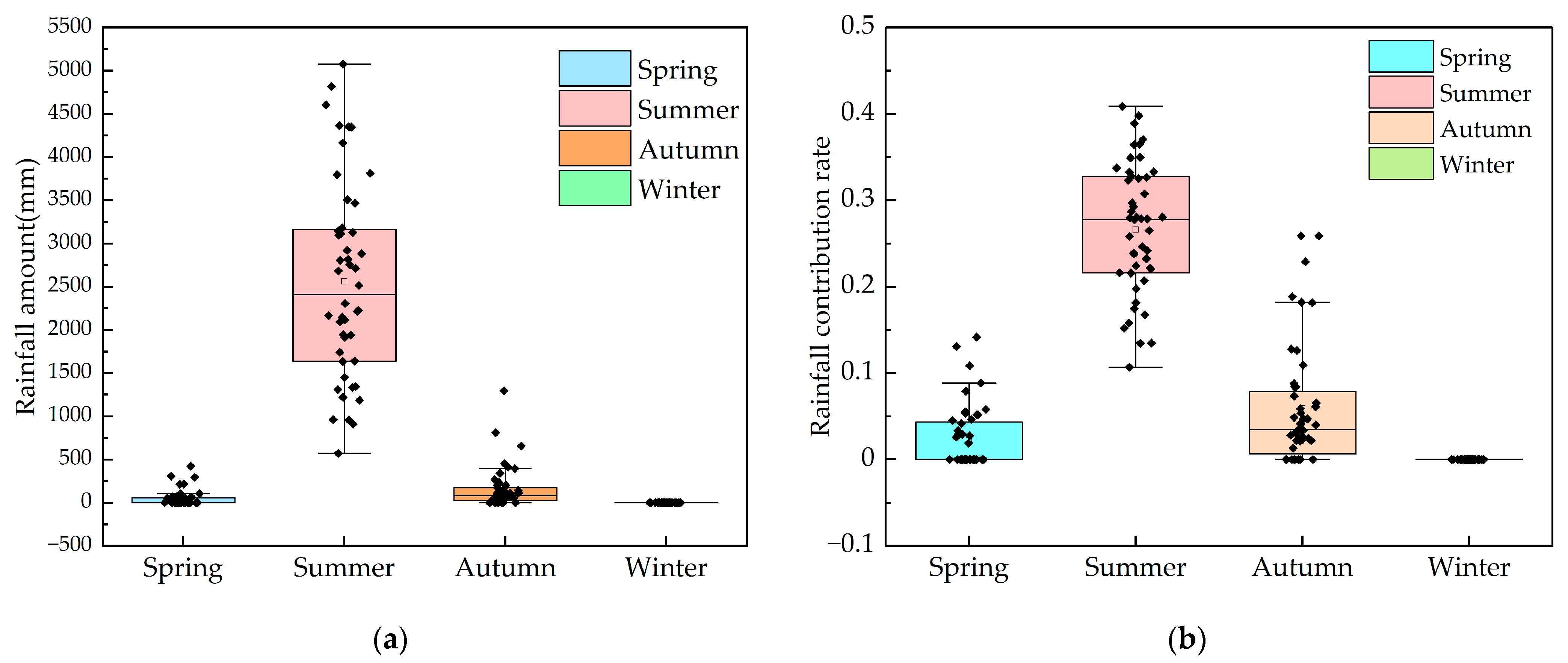

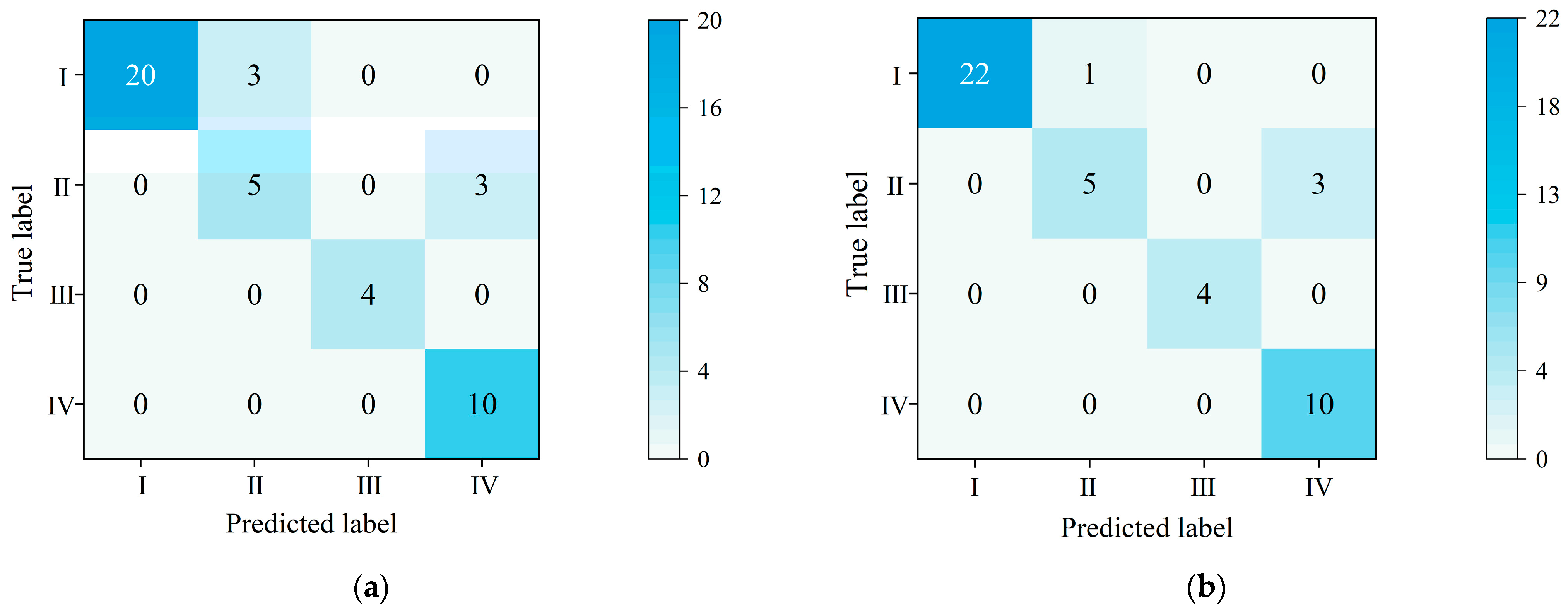
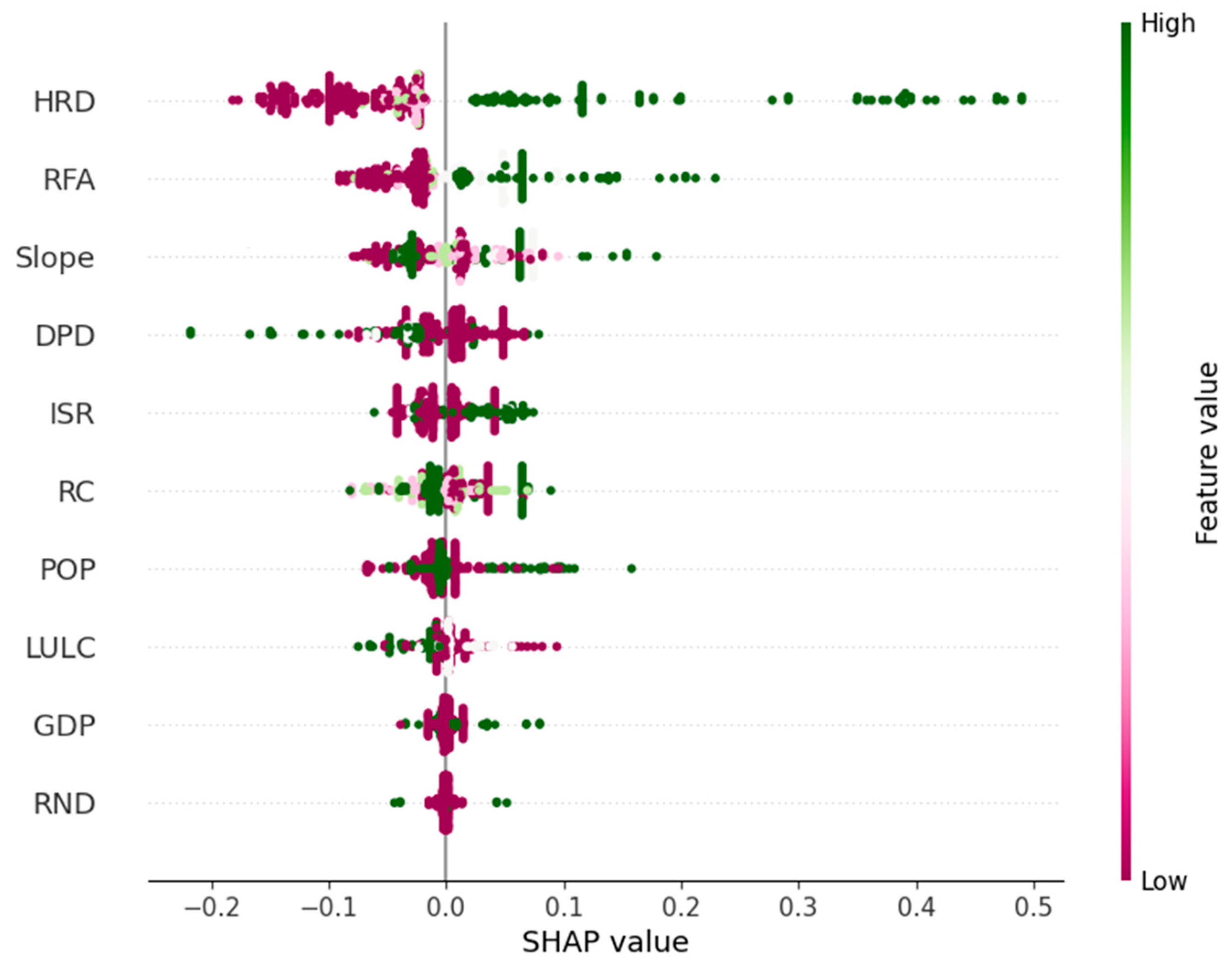
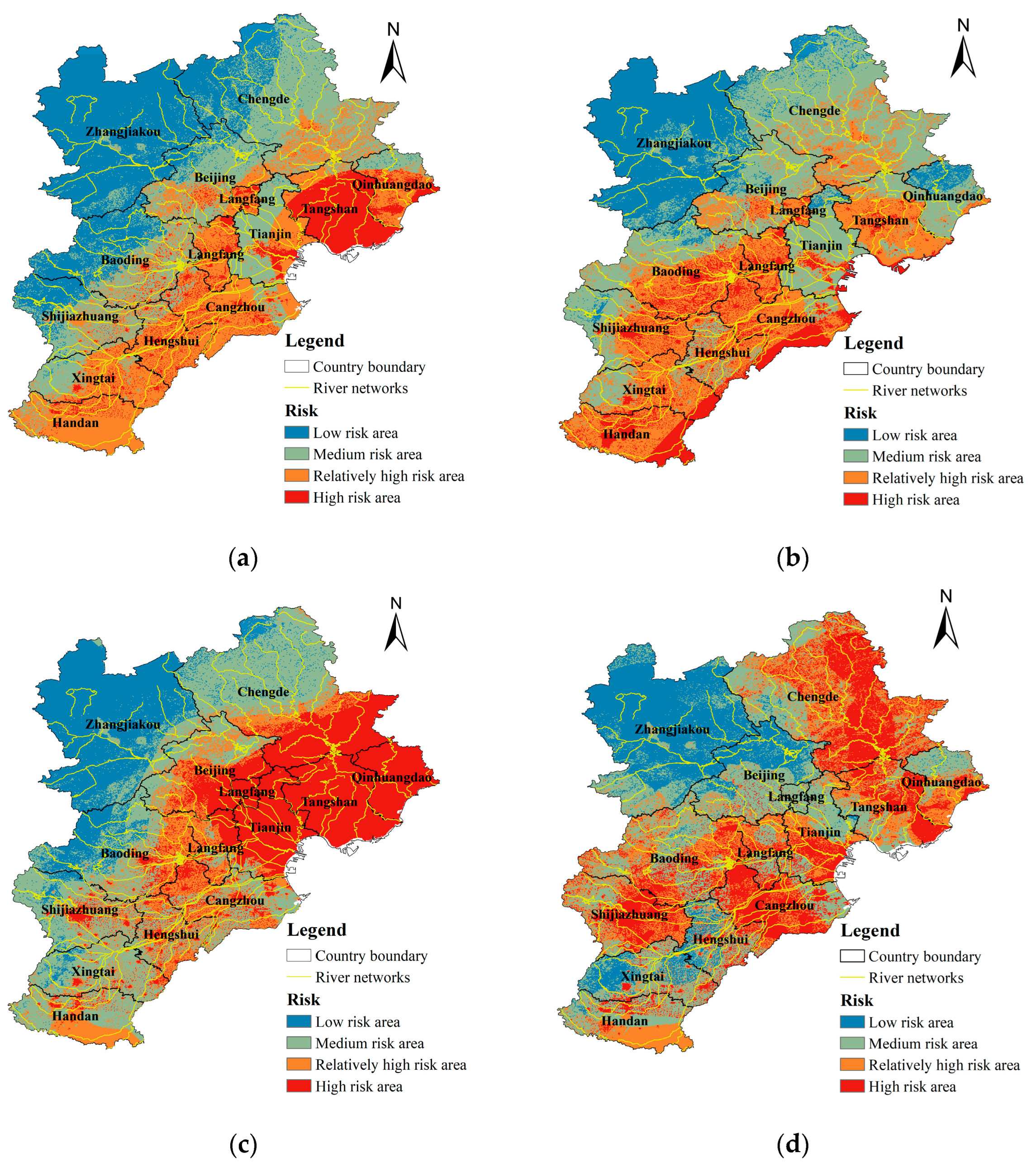
| Index | Year | Month | Day | RD | RA | AI | RJ | RS | FD |
|---|---|---|---|---|---|---|---|---|---|
| 1 | 2018 | 8 | 7 | 2 | 3 | 0 | 0 | 0 | 1 |
| 2 | 2018 | 7 | 24 | 1 | 1 | 0 | 0 | 0 | 1 |
| 3 | 2017 | 8 | 23 | 1 | 2 | 0 | 0 | 0 | 1 |
| 4 | 2017 | 8 | 12 | 1 | 1 | 0 | 0 | 0 | 1 |
| 5 | 2017 | 6 | 23 | 1 | 1 | 1 | 1 | 1 | 1 |
| 6 | 2016 | 7 | 20 | 2 | 4 | 1 | 1 | 1 | 1 |
| 7 | 2016 | 7 | 20 | 2 | 4 | 1 | 2 | 1 | 2 |
| 8 | 2016 | 7 | 19 | 2 | 4 | 1 | 4 | 4 | 3 |
| 9 | 2016 | 6 | 23 | 1 | 2 | 0 | 0 | 0 | 1 |
| 10 | 2014 | 8 | 31 | 1 | 1 | 1 | 1 | 0 | 1 |
| Object | Criterion | Indicator | Abbreviation | Data Source | Unit |
|---|---|---|---|---|---|
| Heavy rain disaster risk | Disaster-causing factors | Heavy rain days | HRD | https://m.data.cma.cn/ accessed on 12 December 2023 | d |
| Rainfall amount | RFA | mm | |||
| Rainfall contribution rate | RC | ||||
| Disaster-prone environment | Slope | Slope | https://www.gscloud.cn/ accessed on 12 December 2023 | degree | |
| Impervious surface ratio | ISR | Annual China Land Cover Dataset | km/km2 | ||
| Disaster-bearing body | Population density | POP | https://www.resdc.cn/ accessed on 12 December 2023 | P/km2 | |
| GDP density | GDP | https://www.resdc.cn/ accessed on 12 December 2023 | k/km2 | ||
| Land Use/Land cover | LULC | Annual China Land Cover Dataset | |||
| Disaster mitigation capacity | Road network density | RND | China Urban Construction Statistical Yearbook | km/km2 | |
| Drainage pipe density | DPD | China Urban Construction Statistical Yearbook | km/km2 |
| Indicator | I | II | III | IV |
|---|---|---|---|---|
| HRD | 0–3 | 3–5 | 5–7 | 7–15 [43] |
| RFA | 100–200 | 200–400 | 400–800 | >800 [11] |
| RC | 0–0.175 | 0.175–0.35 | 0.35–0.525 | >0.525 [44] |
| Slope | <6 | 6–15 | 15–25 | >25 [45] |
| ISR | 0–0.1 | 0.1–0.2 | 0.2–0.3 | >0.3 [46] |
| POP | 0–300 | 300–500 | 500–700 | >700 [47] |
| GDP | 0–2000 | 2000–3000 | 3000–4000 | >4000 [48] |
| LULC | 4 2 | 3 | 1 7 | 5 6 8 9 [49] |
| RND | 0–3 | 3.0–4.5 | 4.5–6.0 | >6.0 [43] |
| DPD | 8> | 8–6 | 6–4 | 4–2 [43] |
| Hyperparameter | Definition | SCV-RF | MAML-RF |
|---|---|---|---|
| n_estimators | Number of decision trees | 14 | 12 |
| max_depth | The maximum depth of decision tree | 8 | 6 |
| min_samples_leaf | The minimum number of samples of leaf nodes | 2 | 2 |
| min_samples_split | The minimum number of samples required for internal node splitting | 3 | 3 |
| Training Set | Test Set | |||
|---|---|---|---|---|
| Evaluation accuracy | SCV-RF | MAML-RF | SCV-RF | MAML-RF |
| Accuracy | 91.35% | 92.31% | 86.67% | 91.11% |
| Precision | 93.50% | 94.74% | 88.20% | 91.91% |
| Recall | 91.35% | 92.31% | 86.67% | 91.11% |
| Criterion | Risk Factors | Factor Weights |
|---|---|---|
| Disaster-causing factors | HRD | 0.302 |
| RFA | 0.118 | |
| RC | 0.099 | |
| Disaster-prone environment | Slope | 0.113 |
| ISR | 0.104 | |
| Disaster-bearing body | POP | 0.074 |
| GDP | 0.036 | |
| LULC | 0.041 | |
| Disaster mitigation capacitycriterion | RND | 0.007 |
| DPD | 0.106 |
Disclaimer/Publisher’s Note: The statements, opinions and data contained in all publications are solely those of the individual author(s) and contributor(s) and not of MDPI and/or the editor(s). MDPI and/or the editor(s) disclaim responsibility for any injury to people or property resulting from any ideas, methods, instructions or products referred to in the content. |
© 2025 by the authors. Licensee MDPI, Basel, Switzerland. This article is an open access article distributed under the terms and conditions of the Creative Commons Attribution (CC BY) license (https://creativecommons.org/licenses/by/4.0/).
Share and Cite
Fan, Y.; Wang, Y.; Xie, W.; He, B. Risk Assessment of Heavy Rain Disasters Using an Interpretable Random Forest Algorithm Enhanced by MAML. Appl. Sci. 2025, 15, 6165. https://doi.org/10.3390/app15116165
Fan Y, Wang Y, Xie W, He B. Risk Assessment of Heavy Rain Disasters Using an Interpretable Random Forest Algorithm Enhanced by MAML. Applied Sciences. 2025; 15(11):6165. https://doi.org/10.3390/app15116165
Chicago/Turabian StyleFan, Yanru, Yi Wang, Wenfang Xie, and Bin He. 2025. "Risk Assessment of Heavy Rain Disasters Using an Interpretable Random Forest Algorithm Enhanced by MAML" Applied Sciences 15, no. 11: 6165. https://doi.org/10.3390/app15116165
APA StyleFan, Y., Wang, Y., Xie, W., & He, B. (2025). Risk Assessment of Heavy Rain Disasters Using an Interpretable Random Forest Algorithm Enhanced by MAML. Applied Sciences, 15(11), 6165. https://doi.org/10.3390/app15116165






